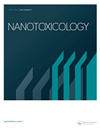
Nanotoxicology
納米毒理學(xué)
- 期刊周期:Quarterly
- 研究方向:醫(yī)學(xué)
- 影響因子:5.955
- 通訊地址:INFORMA HEALTHCARE, 52 VANDERBILT AVE, NEW YORK, USA, NY, 10017
- 官網(wǎng):http://informahealthcare.com/nan
- 投稿地址:http://mc.manuscriptcentral.com/tnan
- 審稿速度:約3.5個(gè)月
中文簡(jiǎn)介
該雜志邀請(qǐng)有關(guān)納米結(jié)構(gòu)材料與生物之間相互作用研究的貢獻(xiàn)。這種相互作用被稱為“干濕界面”。雖然以分子形式呈現(xiàn)給生物體的物質(zhì)的毒理學(xué)特性受到經(jīng)典毒理學(xué)的支持,但在存在毒理學(xué)機(jī)制(主要由表面化學(xué)決定)的情況下,似乎存在分子或原子聚集的大小范圍。正是這個(gè)大小范圍定義了這個(gè)日志的范圍。盡管該雜志的大部分活動(dòng)將涉及對(duì)與納米尺度材料的生物相互作用的研究,但其范圍不應(yīng)就此結(jié)束,而應(yīng)擴(kuò)大到包括所有人造納米結(jié)構(gòu)材料,例如,包括活組織與假體表面之間的相互作用(例如,磨損能生產(chǎn)納米顆粒)或“生態(tài)納米毒理學(xué)”(即納米材料在生物圈中的運(yùn)動(dòng)、與細(xì)菌、無(wú)脊椎動(dòng)物和脊椎動(dòng)物的相互作用)。本雜志范圍內(nèi)相互作用的性質(zhì)包括納米結(jié)構(gòu)材料及其分解產(chǎn)物在人類、實(shí)驗(yàn)動(dòng)物、環(huán)境和生物群中的流動(dòng)性、持久性和毒性。通過(guò)使用活體外和活體內(nèi)風(fēng)險(xiǎn)評(píng)估方法來(lái)評(píng)估和測(cè)量這種相互作用的技術(shù)發(fā)展是本雜志感興趣的一個(gè)主要領(lǐng)域。這些包括在生物系統(tǒng)中納米顆粒通過(guò)膜的傳輸機(jī)制。在顆粒毒性領(lǐng)域,雜志希望鼓勵(lì)提交論文的具體領(lǐng)域包括:與粒徑減小相關(guān)的毒性機(jī)制。這些研究包括有助于理解與基本生理機(jī)制的潛在相互作用,如離子轉(zhuǎn)運(yùn)、K通道和鈣攝取。同樣具有相關(guān)性的還有顆粒的催化表面性質(zhì)與其毒性的相關(guān)性、納米顆粒作為佐劑的重要性及其在免疫毒性中的相關(guān)性以及納米結(jié)構(gòu)表面自由基生成的重要性。該雜志特別關(guān)注通過(guò)涂層和其他方法將毒性降至最低的方法,例如納米顆粒在治療疾病中的醫(yī)學(xué)和治療用途。該雜志在其范圍內(nèi),通過(guò)職業(yè)和人群研究以及對(duì)照臨床研究的流行病學(xué)論文,包括納米結(jié)構(gòu)材料的危害證據(jù)。
英文簡(jiǎn)介
The journal invites contributions addressing research into the interactions between nano-structured materials and living matter. This interaction has been dubbed the 'wet dry interface'. While the toxicological properties of substances presenting to organisms as molecules comes under aegis of classical toxicology, there appears to be size range of aggregations of molecules or atoms where there are toxicological mechanisms which are determined predominantly by surface chemistry. It is precisely that size range which defines the scope of this journal. Although much of the activity of the journal will involve investigations of the biological interactions with nano-scale materials, its scope should not be seen to end there but to extend to include all man-made nano-structured materials, for example including the interactions between living tissues and the surfaces of prostheses (e.g. wearing can produce nanoparticles) or in the context of 'eco-nanotoxicology' (i.e. the movement of nanomaterials through the biosphere, interactions with bacteria, invertebrates and vertebrates). The nature of the interactions within the scope of the journal includes the mobility, persistence and toxicity of nano-structured materials and their breakdown products in humans, experimental animals, the environment and within biota. Developments in technique for assessing and measuring such interactions through the use of in vitro and in vivo methods for risk assessments are a major area of interest for the journal. These include mechanisms of transport of nano-particles across membranes in living systems. Specific areas in the field of particle toxicity in which the journal wishes to encourage submission of papers include: the mechanism of toxicity associated with diminishing particle size. These include investigations leading to understanding of potential interactions with basic physiological mechanisms such as ion-transport, K-channels and Ca uptake. Also of relevance are the relevance of catalytic surface properties of particles to their toxicity, the importance of nano-particles as adjuvants and their relevance in immuno-toxicity and the significance of free radical generation at nano-structured surfaces. The journal is particularly interested in methods of toxicity minimisation, through coatings and other methods, in fields such as the medical and therapeutic use of nano-particles in the treatment of disease. The journal includes within its scope evidence of harm from nano-structured materials through epidemiological papers from occupational and population studies as well as controlled clinical studies
近年期刊影響因子趨勢(shì)圖
相關(guān)醫(yī)學(xué)SCI期刊推薦
- BimonthlyJANAC-JOURNAL OF THE ASSOCIATION OF NURSES IN AIDS CARE
- MonthlyJOURNAL OF REHABILITATION MEDICINE
- QuarterlyPHARMACOLOGICAL REVIEWS
- QuarterlyJournal of Community Health Nursing
- MonthlyJOURNAL OF CLINICAL MICROBIOLOGY
- QuarterlyCANCER AND METASTASIS REVIEWS
- QuarterlyCLINICS IN PLASTIC SURGERY
- MonthlyActas Urologicas Espanolas
- MonthlyJOURNAL OF MAGNETIC RESONANCE IMAGING
- Pain Research & Management
SCI期刊欄目
SCI期刊 工程技術(shù) 物理 生物 化學(xué) 醫(yī)學(xué) 農(nóng)林科學(xué) 數(shù)學(xué) 地學(xué)天文 地學(xué) 環(huán)境科學(xué)與生態(tài)學(xué) 綜合性期刊 管理科學(xué) 社會(huì)科學(xué)
期刊論文百科問(wèn)答
- sci投稿中關(guān)于online常見(jiàn)的問(wèn)題匯總
- 攝影藝術(shù)領(lǐng)域AHCI期刊推薦《Photography And Culture》
- Nature旗下多學(xué)科子刊Nature Communications
- 中小學(xué)教師值得了解,這些教育學(xué)期刊發(fā)論文容易被人大復(fù)印轉(zhuǎn)載
- 2025年寫(xiě)管理學(xué)論文可以用的19個(gè)選題
- 測(cè)繪領(lǐng)域科技核心期刊選擇 輕松拿捏
- 及時(shí)開(kāi)論文檢索證明很重要
- 中國(guó)水產(chǎn)科學(xué)期刊是核心期刊嗎
- 國(guó)際出書(shū)需要了解的問(wèn)題解答
- 合著出書(shū)能否評(píng)職稱?
